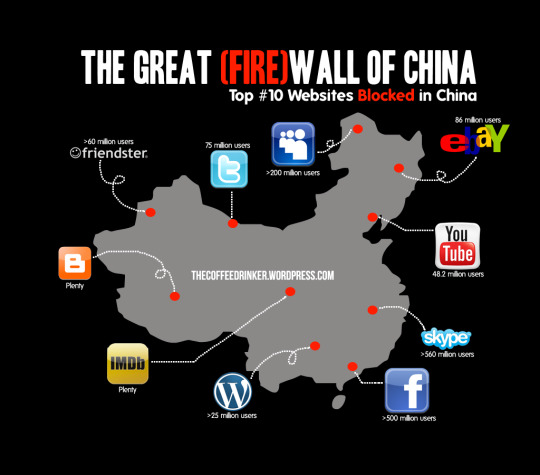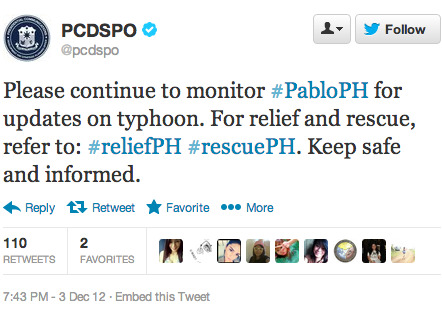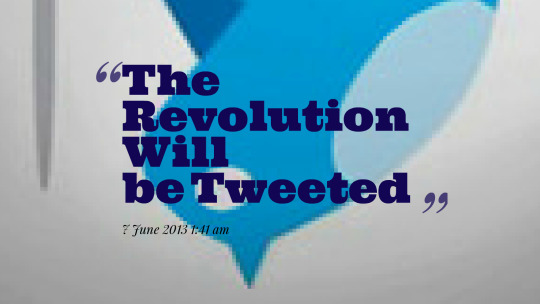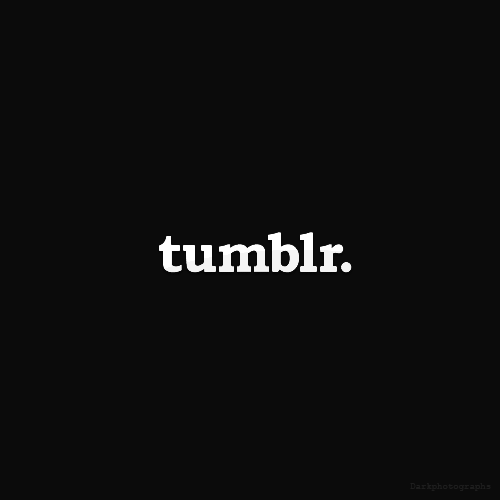An academic blog by Lincoln Edmunds focusing on weekly topics as studied in MDA20009 -Digital Communites at Swinburne University of Technology.
Don't wanna be here? Send us removal request.
Text
The Social Media Environment in China
Whilst social media is seen as common and a daily practice in most western countries, some countries are not afforded the same luxury. This could be due to a lack of infrastructure or political reasons. In China’s case their own government created an internet firewall which essentially censored out various parts of the internet, blocking the Chinese people from accessing websites that were blacked out. This has been dubbed ‘The Great Firewall of China’. China does not allow access to Facebook and Twitter, two of the biggest social media platforms found online. You’d be quick to assume that the Chinese people are missing out in the social media experience, however as we delve deeper it is clear that there certainly is a social media presence in China after all. And in a damn big way.

There are 600 million internet users in China, a staggering number in itself. Put into context that is double the amount of online users from America. Whilst they don’t have access to the major western websites, China has the fastest growing social media environment across the globe. It is a huge market to capitalise on, with limited international competition. On average 9.1 out of 10 Chinese internet users have a social media account, significantly larger when compared to America which averages 6.7 out of 10 users.
A leading social network is called ‘Qzone’ which is currently estimated to have 645 million members. The website is best described as a combination of Facebook and Tumblr where users can write blogs, send photos, listen to music and watch videos. 150 million Qzone members update their accounts at least once a month, making it one of the most active online communities in the industry.
Social media in China, as with many countries, has provided a springboard for citizens’ to project their political issues online and create online campaigns. The notoriously strict Chinese Government can now be criticised online through social networks, with many users projecting their concerns regarding freedom of speech and other political agendas.

Whilst the Chinese are denied access to mainstream western social networks, they are by no means hindered by a lack of other options and content. The fact that China’s social media is one of the largest online networks which is continually expanding indicates that there is plenty of potential for future grow and improvements to the already impressive network of sites.
0 notes
Text
Social Gaming
Since the introduction of video game consoles in the late 20th century, video games have been a staple form of entertainment for many young Australian kids. In fact video games are not just popular with teenagers with research suggesting that adults are the prime users of digital games, with the average gamer’s age estimated to be 31.

However along with many forms of technology video games have learnt to evolve, developing a social side to enhance the gaming experience. This can be seen in console gaming systems and even in simple online internet games that can be accessed through social networks. Several examples can be found on Facebook, with many games being specifically created with social interaction as a key concept in the function of the game. Applications and mobile games are also known to tap into social qualities, with many developers deciding to pair up with social networks to include sharing features within the app.
An example of this is the well-known puzzle game known as “Candy Crush”. This simple yet addictive game focuses on the player matching three or more pieces of a coloured candy together in the aim to reach the set level score in a certain amount of turns. As the player progresses the levels get increasingly harder and challenging.
youtube
Candy Crush was created for the social network Facebook and an account is required to play. Through this partnership a social element is introduced and you can compare scores to other Facebook friends and see how many levels they have successfully navigated through thus far.
Console gaming has also changed significantly over time, not just in the development of the actual games themselves, but with the introduction of social features with the motivation of enhancing the overall gaming and console experience. Once upon a time console gaming systems could only play video games and that was pretty much it. Now you can connect your Facebook and YouTube accounts, browse the internet, watch TV, talk to friends in party chats and much more. The overall introduction of these elements has expanded and enhanced the overall gaming experience and made it easier for the gaming community to interact and engage with each other.
0 notes
Text
Public Health & Online Campaigns
With the increased use of social media, particularly in the past decade, many health organisations and charities have realised the potential impact that online campaigns can have across the web. It is very likely that you personally have come across a health message or campaign nestled in amongst your newsfeed on most social media sites, whether that was by personal choice or not.
Technology has always played a big role in creating messages and spreading them through the wider community, especially when relating to social health issues. Everyone will remember the famous TAC slogan “If you drink and drive, you’re a bloody idiot”. Traditional mediums such as Television and Radio were the frequent drivers of these messages in the late 20th century. But since then the introduction of social media has developed additional platforms that have the ability to reach a larger and more diverse potential audience, with new and creative ways capturing online attention.

While the issue and cause of social health campaigns might focus around a serious topic, the actual campaign itself can be fun and creative. A classic example is the now well-known men’s health charity by the name of Movember.
This event takes place during November and predominantly involves male participants being sponsored to grow a moustache and other facial hair styles whilst documenting the activity over a one month period. This can be achieved through social media sites that allow the participants to share their progress to friends and other online members.
The campaign began in Australia in 2004 and was centred on the issue of prostate cancer. The charity is now a recognised global brand and in 2012 raised over $141 million dollars in Australia. By focusing the campaign around a creative and fun challenge, the charity were able to target an audience of younger males who would typically avoid this specific topic regarding men’s health.

Another reason why Movember has been so successful is because it has a large digital footprint and uses a vast range of social media services to promote their campaign. Movember has a strong presence on Facebook, Twitter, Instagram, YouTube and Pinterest. All of these social media sites have been fundamental to the success of the charity as they are able to connect to the target audience of younger males more effectively by focusing on popular mediums consumed by this generation.
Regular citizens and participants are able to use these social networks to notify friends and the online community of their participation in the charity. For those who officially sign up to the Movember website, they contain a personal profile that shows progress over the month and allows people to donate to their cause. During the initial set up the participant can set a target goal of money they wish to raise and social media networks are a great driving factor behind individual promotion and awareness.
0 notes
Text
Crowdsourcing in times of distress
Whilst technology has improved and enhanced many aspects of society, unfortunately it cannot prevent some issues that take place throughout our community, such as natural and man-made disasters. However the role of technology in these situations has developed overtime and new methods such as crowdsourcing can provide crucial information in desperate times.
The radio and television are still seen as major communication points for information during disasters, however the spontaneous nature of these events means that not everyone has access to these mediums. This is where mobile phones and portable social networking services can prove their worth immensely, with information and news spreading throughout the online community as it happens. Whether this is through professional organisations and bodies such as the CFA, Police, other emergency services etc., or just an ordinary member of society who is live on the scene and providing information online.

The emerging trend of “crowdsourcing” can be described as the spread of knowledge and resources accessible through social media platforms. Crowdsourcing can provide live updates as they progress from witnesses on the scene, which enables users to share and pass that information on.
Facebook and Twitter are probably the two best examples of social networks that best enable the use of effective crowdsourcing. Facebook’s ‘share’ feature enables users to take the original post and display the message on their own timeline, sharing that to every friend they are connected with on the site. While Twitter works similarly with the ‘retweet’ function, enabling that ‘tweet’ to reach all of their fellow followers.
Facebook however has taken the idea of crowdsourcing to a whole new level with the introduction of certain social features during times of crisis. The health and wellbeing of family members during disasters is at the forefront of most people’s minds and sometimes communication networks such as phone lines can became jammed due to demand and other issues during these situations.

This is where Facebook has been able to provide clarity and information in recent years, enabling loved ones to reach out to each other online. Facebook saw the interaction that took place during these events and decided to introduce a feature that enabled users to notify their friends’ list that they were safe during big disasters. This was seen during the Nepal Earthquake of 2015, with Facebook CEO Mark Zuckerberg saying “When disasters happen, people need to know their loved ones are safe. It's moments like this that being able to connect really matters”.
It is quite clear that when disaster strikes crowdsourcing is a viable and important method of communication between both loved members of the community and emergency services alike.
0 notes
Text
Cyber-bullying and Trolls
For all the great features that social media contains, there is one large and particularly ugly negative associated with the online environment, cyber-bulling and trolling. This is especially prevalent in the younger generation but more seasoned members of the online community are not immune from this issue either. Unfortunately whilst social media has made it easier to communicate to family and friends, it has also enhanced the ability to be exposed to bullies and trolls, enabling the provoker to attack and criticise from protection behind a screen.
This is an issue widespread across all social media platforms and is not associated stronger with one platform compared to another. It is everywhere. Such is the severity and seriousness of the issue, laws were put into place to charge those who participated in cyber-bullying online.

This issue is not just restricted to everyday citizens however, even famous celebrities cop a monumental amount of abuse online just because they are an easy target. The big issue with online environments is people change their normal characteristics and behaviour as compared to how they would behave in the real world. You can guarantee that 90% of internet trolls would not say something they said online to the face of that same person if confronted in real life. Unfortunately most of these trolls are just seeking attention and a few cheap laughs.
Whilst trolls might be annoying and a nuisance, the issue of cyber-bullying is much more serious. Young teenagers who are still developing physically and mentally are very vulnerable and being targeted by bullies online is unfortunately a major problem for many Australian children. By the age of 15 it is believed that 1 in 5 Australian children have experienced cyber-bullying. Just as shocking is that the average Australian school received 22 complaints of cyber-bullying each year, the average size of a classroom.

Cyber-bullying can be much more damaging compared to physical bullying because it is relentless and harms the mental psyche of the victim. The home is a place where you suppose to feel safe and secure, but social media and cyber-bulling has the ability to make the victim feel uncomfortable and upset in their own home. Unfortunately for some, this constant tirade of abuse is so bad that they see no other way around it, other than to end it by taking their own life.
Since people have realised the significance and harm caused by cyber-bullying, the issue has begun to be treated with more respect and support networks have been established to battle this relatively new problem. But whilst there are these new websites and networks aimed at combatting cyber-bullying, the whole environment around cyber-bullying is difficult to police and manage making it a tricky issue for all involved.
0 notes
Text
Digital Activism and Protest
When most people think of social media they think of engaging with friends and family, sharing photos, stories and other personal information. However social media is much more than this and has the power to bring people together on a whole different scale. Digital activism and protests are very prominent on social media and digital platforms can be used as tools to exploit political agendas and spark grass roots activism.
Any average human being can create an account on Facebook, Twitter and YouTube, potentially broadcasting their message to millions of viewers. Not only can they reach a bigger audience in their own country, they can also go globally with no limitations on how far their message can spread throughout society.

The digital tools created through social media have made it easier than ever in the history of the human race to share your opinion with the rest of the population. This can be achieved through simple features found in digital platforms, such as sending out a tweet, sharing a status’ or uploading a video.
There have been many examples of digital activism over the past few years as the increase in use of social media continues to rise. An example of this is the Paris attacks, where Facebook users had the opportunity to show support to France by changing their profile picture to feature a silhouette of the French flag.

Social media is a new form of power compared to the past because the noise is created from genuine members of society, who are pushing the agendas, not out of touch politicians and members of the media who were previously the only strong voice in society. It is essentially ‘people power’ that when organised and efficient have the potential to form both online and real world protests in strong numbers.
As seen throughout history, revolutions were created when the working class spoke up and took power through sheer weight of numbers. Social media has to ability to create a cult following and potentially establish numbers large enough for an uprising to challenge traditional forms of power.
0 notes
Text
The odd couple? Social Media and Politics
The relationship between politicians and social media is a rather fascinating conversation point. Many politicians have realised that they can spread their message and political agendas in new and powerful ways through social media.
Once restricted to broadcast and promote messages through old traditional media platforms such as TV and Radio, politicians can now connect to users on a more personal level through social media.
It is very common for frequent users of social media platforms such as Facebook and Twitter to find politicians appearing in their feed, be it intentional or not. I recently have found Premier Daniel Andrew’s popping up quite frequently on my timeline, as he continues to promote his governments’ positive agendas currently taking place, such as the removal of level crossings for example.

Of course politicians are not going to focus too much on the negative press around their policies. Their main driving factor behind social media use will be to keep pushing their policies, whilst also attacking and criticising their opposition’s faults.
But on the other side of the coin, whilst they can control what posts and messages are sent out on social media, the ability to control the public’s reaction and comments on their posts is much more difficult to manage.
This is where social media has created a new set of rules regarding politics, as it is much easier to view the public’s opinion than ever before, be it through serious debate or humour through memes and other parodies.
You only have to click on one politician’s status and you won’t have to scroll down too far before you see a hate speech or rant on why they or their policies are no good. The general public’s power on social media should not be underestimated.
Users for the first time have the social tools to develop a following on various platforms and project their opinions and facts on politicians and spark movements for and against certain parties.
Whilst many people think of social media as a place where people come for entertainment and news, these platforms also play a crucial role within political campaigns and agendas.

0 notes
Text
Tumblr: Blog or Social Network?
Whilst on the surface Tumblr appears to contain features which would place it under a blog based website, upon further inspection it can be revealed that there also many social network features integrated within the site, which are also an integral part of Tumblr’s functionality and structure.
Whilst Facebook and Twitter are easily distinguished as social networking platforms, Tumblr’s definition is slightly blurred by the multiple functions and extra features it contains compared to the other platforms. Tumblr is different from these other two websites because users are encouraged to post deeper and more personal anecdotes through blogging.

Tumblr, for me anyway, seems to speak out on a more emotional level compared to Facebook and Twitter. Facebook is not designed to have long 300-400 word status updates and Twitter deliberately restricts this, with a 140 character limit per tweet. But because Tumblr was formed around a blogging culture, it is much more acceptable and suitable to branch out with more emotive and extended posts.
Whilst Tumblr’s primary functionality was based around “microblogging”, a series of short text based posts created by users, it is quite easy to see why it is also considered a social network with some of its other features.
The alibility to like, share, follow and hashtag are some of the social features that can be found in Tumblr, along with individual profiles and photos. These are important features of the site as they help users build up a following, promote posts and share content with other users.
Perhaps it is these social tools that have helped Tumblr stand out and gain popularity over traditional blogging websites. The addition of social elements has enhanced the platforms’ functionality, with users able to extract and find relevant posts easier and tailor made to their interests.
This can be backed up by Tumblr’s raging success in number of users and posts each and every day across the globe. As of February 2016, the site had 129.7 billion posts with 280 million blogs.
It would be fair to say Tumblr does not fall under the direct category of either a blog or social network. It would be more reasonable to look at the website as an overlap of the two categories, drawing characteristics from both, but not distinctly standing out to favour one over the other.
0 notes